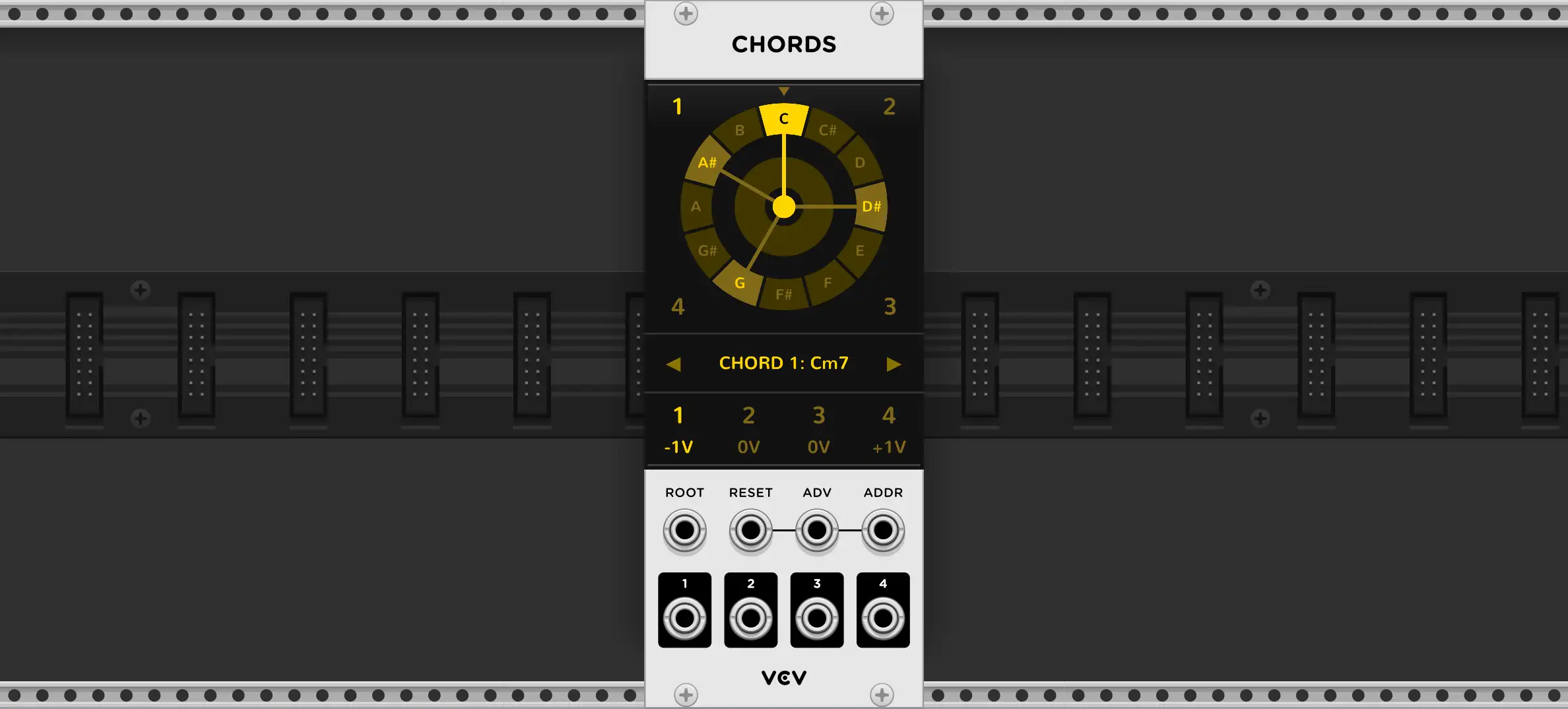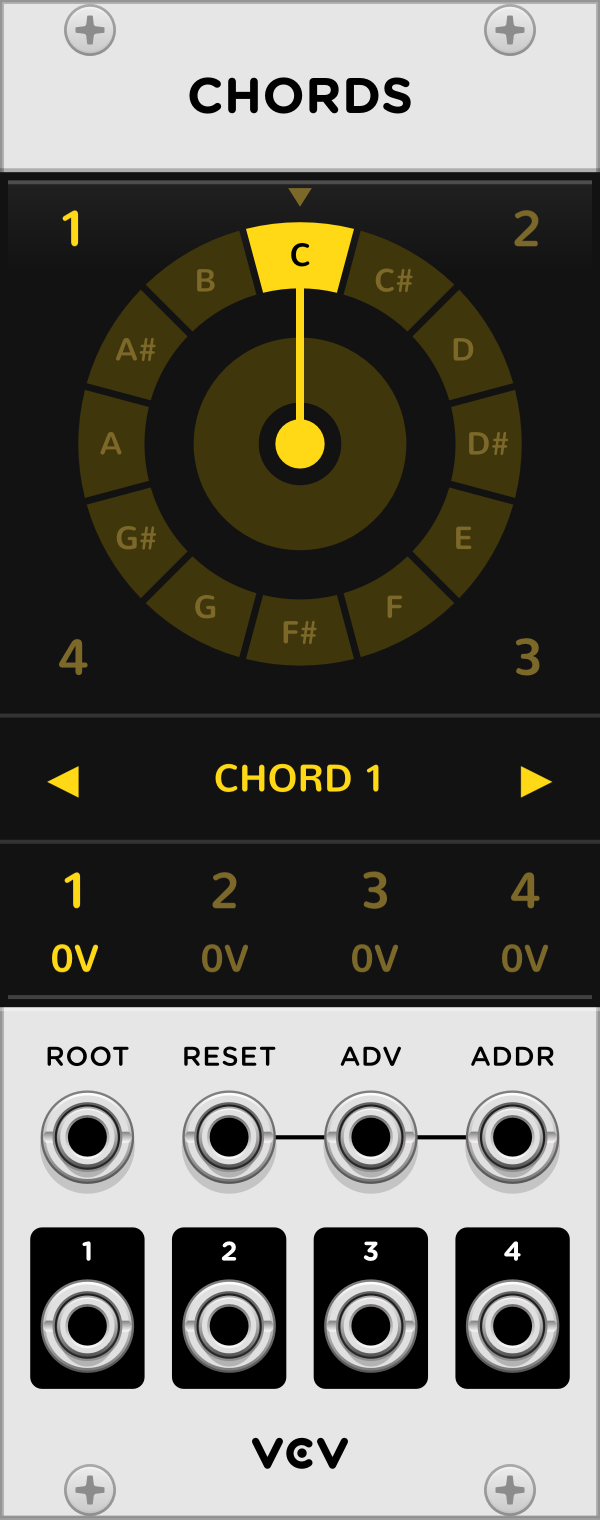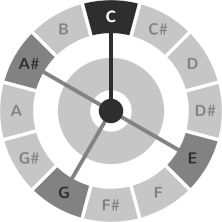
Expand a single 1V/oct pitch into a chord of up to 4 notes.
Program your own chords and sequence them with triggers or direct CV addressing.

VCV Chords
The fundamental idea of Chords is to expand a single 1V/oct pitch CV into a four-note chord, with sequencer-like control over the choice of chord. This allows you to more easily arrange a song with a chord progression, adopt music theory in your patches, and create polyphonic (or arpeggiated) music.
Chromatic Circle

The main circular display of Chords arranges the 12 notes of the chromatic scale in a circle.
In its initial state, all four note handles are assigned to the root note C. Click and drag a handle in a circular motion to set a note. Each full turn of 360° increases/decreases the note by 1 octave.
Click and drag the circle in the center to transpose all notes by semitones.
Chords
You can store an unlimited number of chords with VCV Chords. Left-click the chord label to open a menu with options to add, duplicate, cut, copy, paste, and delete a chord. When more than one chord is added, click the left/right arrows to cycle through the chords, wrapping around at the end.
If a common name of the current chord is available (such as “C major”), it is displayed next to the chord number.
Inputs
The ROOT input shifts all pitch outputs by its voltage. The note names in the chromatic circle are updated so that the top-most note specifies the root note. This also updates the displayed chord names.
The RESET input sets the chord number to 1 when a trigger is received.
By default, the ADV input advances to the next chord and cycles back to 1 after the last chord is reached. You can change this behavior by right-clicking on the panel and selecting a sequencer direction. Forward is the default, Reverse moves in the opposite direction, Pendulum changes direction when the start/end of the list is reached, Random choses a random chord each trigger, and Brownian randomly moves up or down in the list by 1 chord.
The ADDR input directly sets the current chord by a voltage, scaled from 0V to 10V.
For example, if your chord sequence has 8 chords, an ADDR voltage of 0V sets chord 1, 10/8V (1.25V) sets chord 2, 20/8V (2.5V) sets chord 3, etc. and 7*10/8V (8.75V) sets chord 8.
Voltages outside this range wrap around cyclically.
When a cable is patched into ADDR, the chord selector menu and left/right arrows are disabled and overridden by the ADDR voltage.
Outputs
Each output generates a 1V/oct CV signal for its corresponding note.
To take advantage of polyphonic cables in VCV Rack to avoid using four identical sound generators, select Polyphonic outputs in the context menu. This causes output 2 to generate a 2-channel polyphonic voltage containing pitches 1-2, output 3 to contain pitches 1-3, and output 4 to contain all pitches 1-4. Output 1 is unchanged.
VCV Chords Changelog
2.0.5 (2024-04-28)
- Add dark panel.
2.0.4 (2023-02-22)
- Illuminate display when room brightness is lowered.
- Use
floor(v / 10V * N)instead ofround(v / 10V * N)to select chord using Address input. - Adjust mouse rotation speed of Transpose knob.
1.2.1 (2020-12-13)
- Allow right-clicking (as well as left-clicking in previous versions) the CHORD label to open the chord list context menu.
1.2.0 (2020-08-07)
- Add configurable sequencer direction.
1.1.0 (2020-02-02)
- Allow adding an unlimited number of chords in a chord sequence.
- Added “All chords” factory preset.
1.0.1 (2019-09-10)
- Fix global transposition when pasting a chord.
- Ignore ADV trigger up to 1ms after receiving a RESET trigger, per the VCV standard.
1.0.0 (2019-09-08)
- Initial release.